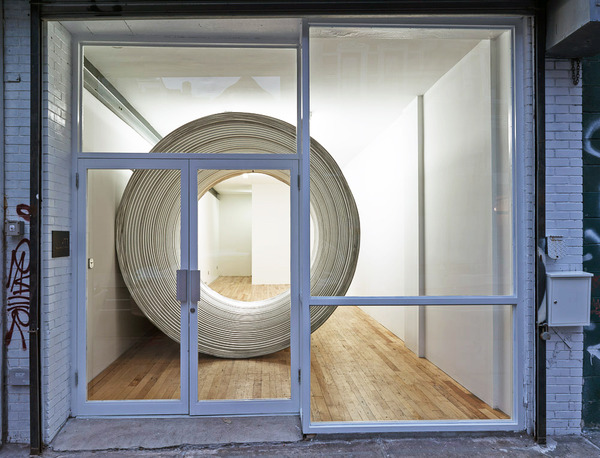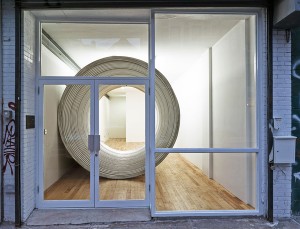-
Be (In) Here Now
by Laila Pedro April 8, 2013

installation shot of Harlan’s Cave (2012). courtesy of JTT, New York.
Charles Harlan’s Cave is, according to gallerist Jasmin Tsou, who was quietly painting the walls when I visited the piece, concerned with ‘the progression of certain types of architecture.’ By situating this installation in juxtaposition with an oblique text that describes various civilizations and various archeological artefacts or geographical features — ranging from Puente Viesgo, Spain, in 38,000 b.c., to 1997 A.D. in Smyrna, Georgia — Harlan has done precisely that: his own work concludes the timeline, as the most recent stage within the broad context of ‘caves’ in human history.
If the concept is initially inscrutable in its range, it is simultaneously fairly simple, revealing a deceptively laconic kind of focus and attention to detail that is fascinating and delighting. Ms. Tsou’s matter-of-fact housekeeping speaks to how the installation works: it is just there, transforming the space, as life goes on around it. The specificity of this moment — of taking the idea of the cave and the installation as a point in its overarching chronological progression — is compelling. For me, however, the most interesting and engaging aspect of the installation was its depth and impact as a physical experience. By zooming in on one specific form, with infinite variations, Harlan activates a whole network of experiences and associations, even as the physical experience is unique to being present in this space, at this time.
It’s for this immediacy and focus of physical presence that Harlan’s broad concept — this exploration of the mutation of a geographical features and multiple ideas it elicits — had to take the form of something as direct and grounding as an installation. The experience of the piece is as quietly astonishing as the concept is broad and evocative. How can a large piece of PVD-piping set in unsettling proportions within the small, low-ceilinged confines of a simple gallery, in an unremarkably dirty and clanging street in the Lower East Side, have the same effect, at once shocking and soothing, as the first breath of country air taken when one hasn’t left the city in a few months?
Part of the answer, I suspect, lies in the fact that both experiences are unemphatic but undeniable shifts in perspective. Photographs cannot convey the physical effect of the pipe’s weird proportions, its weight, its unaccented but uncontestable being there. It plays with the senses on every level, simultaneously muffling street noise even as air moving through generates its own barely perceptible hum. This kind of sensory transformation, encountering a moment or object that, quite literally, gives one pause is one of the sadly underrepresented powers of installation.
Harlan’s approach is not particularly concerned with presentational flourishes: another part of the installation, the pickle overflowing its bottle, seeming to strain the glass, is presented with precisely zero drama. This technique is all the more effective for its simultaneous contrast and affinity to the phenomenological effect of the pipe — completely different objects impact the body in echoingly similar ways. I point to the phenomenological aspect of the experience because I think this is precisely where the confident, meticulous thought-work that goes into these objects plays out. In his mid-century classic The Eye and the Mind , Maurice Merleau-Ponty articulates the subtle channels along which this precisely executed work reverberates:
the mystery lies in the fact that my body is at once seeing and visible. He who looks at everything, can also look at himself, and recognize in what he sees the other side of his seeing power. He sees himself seeing, he touches himself touching, he is visible and tangible to himself.
Cave is carefully calibrated to engender precisely this unsettling but deeply present state, and as Merleau-Ponty described, the viewer is both active in it and, crucially observing his or her own participation
From the first moment of seeing Harlan’s Cave through the glass, certainty evaporates. Sightlines are called into question. Can I walk in ? Is this the right entrance ? Do I walk through it, or go around it ? Like that first breath of country air, it transforms its environment through a series of sensorial shifts. It makes its own sound, which changes as you walk through the gallery, from wooshing, to echoing, to the shocking clanking of your own feet. Situated within the tube, you are frozen in time and space even as you continue to move through them. The pipe feels much longer than it is, because the experience of being contained within its full network of sensory impressions — optical illusion, sound transformation, body in space — is so completely transformative, for such a brief amount of time. Looking through the PVD pipe enacts the crucial difference between a door and a portal.
Ultimately, what makes this installation so successful is that it immediately makes you start looking. The viewer is not given the option of remaining passive for even an instant. The Cave’s real success is as a kind of telescoping or magnifying gesture : you will look here now. And what is the « here » in question ? It’s the gallery, it’s the installation, it’s the experience of looking at and being in and with art.
Charles Harlan’s Cave is on view through April 14 at JTT, 170a Suffolk Street, New York NY 10002.


